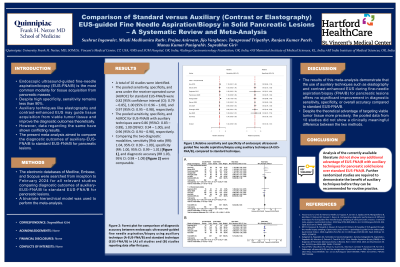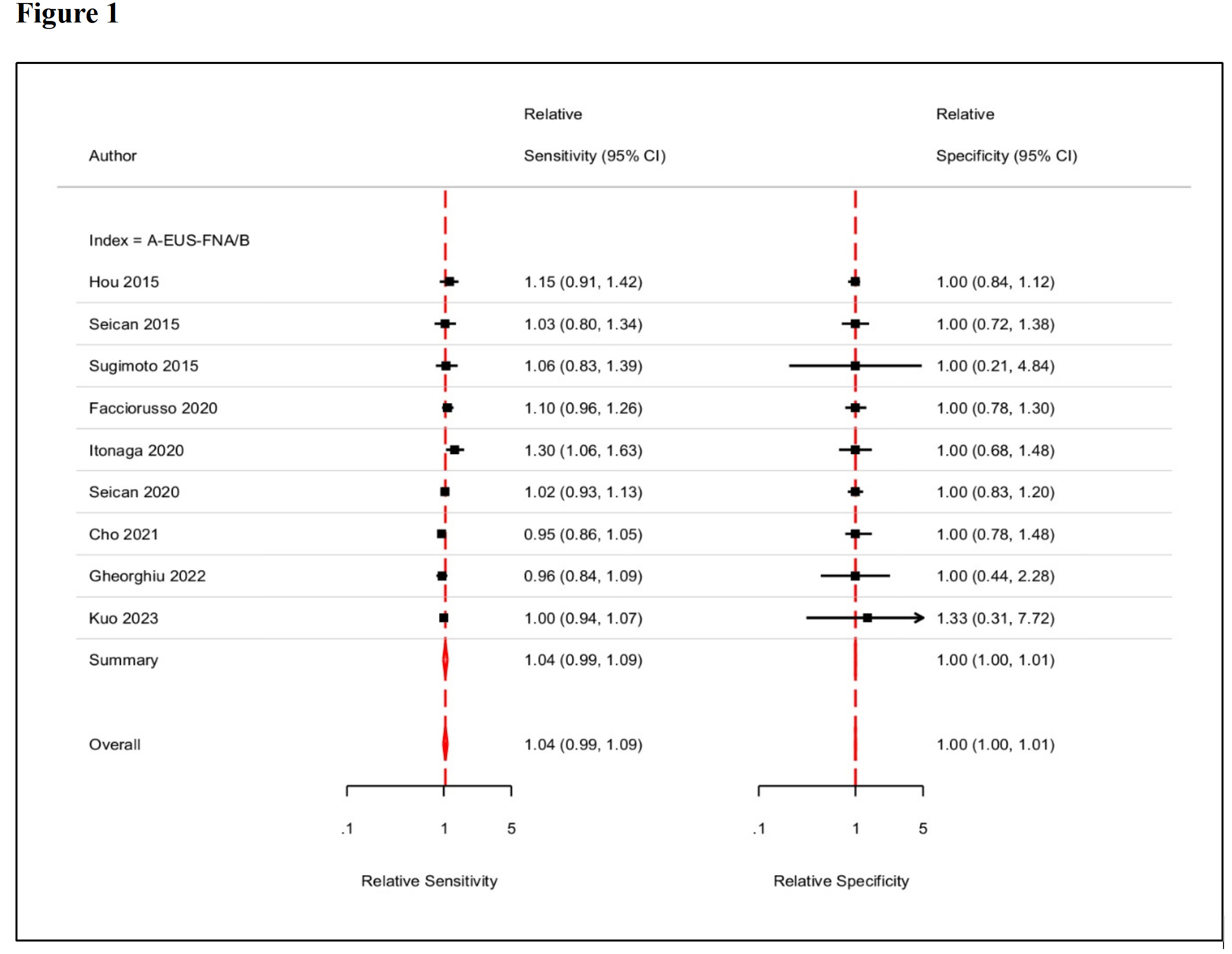Monday Poster Session
Category: Interventional Endoscopy
P2744 - Comparison of Standard versus Auxiliary (Contrast or Elastography) EUS-Guided Fine Needle Aspiration/Biopsy in Solid Pancreatic Lesions: A Systematic Review and Meta-Analysis
Monday, October 28, 2024
10:30 AM - 4:00 PM ET
Location: Exhibit Hall E

Has Audio

Sushrut Ingawale, MD, MBBS
Quinnipiac University Frank H. Netter MD School of Medicine / St. Vincent's Medical Center
Bridgeport, CT
Presenting Author(s)
Sushrut Ingawale, MD, MBBS1, Mitali Madhumita Rath, MD, MBBS2, Prajna Anirvan, DM, MD, MBBS3, Jijo Varghese, DM, MD, MBBS4, Taraprasad Tripathy, MD, MBBS5, Ranjan Kumar Patel, MD, MBBS5, Manas Kumar Panigrahi, MD5, Suprabhat Giri, DM, MD, MBBS6
1Quinnipiac University Frank H. Netter MD School of Medicine / St. Vincent's Medical Center, Bridgeport, CT; 2Institute of Medical Sciences and SUM Hospital, Bhubaneshwar, Maharashtra, India; 3Kalinga Gastroenterology Foundation, Cuttak, Orissa, India; 4NS Memorial Institute of Medical Sciences, Kollam, Kerala, India; 5All India Institute of Medical Sciences, Bhubaneshwar, Orissa, India; 6Kalinga Institute of Medical Sciences, Bhubaneshwar, Orissa, India
Introduction: Endoscopic ultrasound-guided fine-needle aspiration/biopsy (EUS-FNA/B) is the most common modality for tissue acquisition from pancreatic masses. Despite high specificity, sensitivity remains less than 90%. Auxiliary techniques like elastography and contrast-enhanced EUS may guide tissue acquisition from viable tumor tissue and improve the diagnostic outcomes theoretically. However, data regarding the same have shown conflicting results. The present meta-analysis aimed to compare the diagnostic outcomes of auxiliary-EUS-FNA/B to standard EUS-FNA/B for pancreatic lesions.
Methods: The electronic databases of Medline, Embase, and Scopus were searched from inception to February 2024 for all relevant studies comparing diagnostic outcomes of auxiliary-EUS-FNA/B to standard EUS-FNA/B for pancreatic lesions. A bivariate hierarchical model was used to perform the meta-analysis.
Results: A total of 10 studies were identified. The pooled sensitivity, specificity, and area under the receiver-operated curve (AUROC) for standard EUS-FNA/B were 0.82 [95% confidence interval (CI): 0.79 – 0.85], 1.00 (95% CI: 0.96 – 1.00), and 0.97 (95% CI: 0.95 – 0.98), respectively. The pooled sensitivity, specificity, and AUROC for EUS-FNA/B with auxiliary techniques were 0.86 (95%CI: 0.83 – 0.89), 1.00 (95%CI: 0.94 – 1.00), and 0.96 (95% CI: 0.94 – 0.98), respectively. Comparing the two diagnostic modalities, sensitivity [Risk ratio (RR): 1.04, 95% CI: 0.99 – 1.09], specificity (RR: 1.00, 95% CI: 0.99 – 1.01) (Figure 1), and diagnostic accuracy (RR 1.03, 95% CI: 0.98 – 1.09) were comparable.
Discussion: Analysis of the currently available literature did not show any additional advantage of EUS-FNA/B with auxiliary techniques for pancreatic solid lesions over standard EUS-FNA/B. Further randomized studies are required to demonstrate the benefit of auxiliary techniques before they can be recommended for routine practice.

Disclosures:
Sushrut Ingawale, MD, MBBS1, Mitali Madhumita Rath, MD, MBBS2, Prajna Anirvan, DM, MD, MBBS3, Jijo Varghese, DM, MD, MBBS4, Taraprasad Tripathy, MD, MBBS5, Ranjan Kumar Patel, MD, MBBS5, Manas Kumar Panigrahi, MD5, Suprabhat Giri, DM, MD, MBBS6. P2744 - Comparison of Standard versus Auxiliary (Contrast or Elastography) EUS-Guided Fine Needle Aspiration/Biopsy in Solid Pancreatic Lesions: A Systematic Review and Meta-Analysis, ACG 2024 Annual Scientific Meeting Abstracts. Philadelphia, PA: American College of Gastroenterology.
1Quinnipiac University Frank H. Netter MD School of Medicine / St. Vincent's Medical Center, Bridgeport, CT; 2Institute of Medical Sciences and SUM Hospital, Bhubaneshwar, Maharashtra, India; 3Kalinga Gastroenterology Foundation, Cuttak, Orissa, India; 4NS Memorial Institute of Medical Sciences, Kollam, Kerala, India; 5All India Institute of Medical Sciences, Bhubaneshwar, Orissa, India; 6Kalinga Institute of Medical Sciences, Bhubaneshwar, Orissa, India
Introduction: Endoscopic ultrasound-guided fine-needle aspiration/biopsy (EUS-FNA/B) is the most common modality for tissue acquisition from pancreatic masses. Despite high specificity, sensitivity remains less than 90%. Auxiliary techniques like elastography and contrast-enhanced EUS may guide tissue acquisition from viable tumor tissue and improve the diagnostic outcomes theoretically. However, data regarding the same have shown conflicting results. The present meta-analysis aimed to compare the diagnostic outcomes of auxiliary-EUS-FNA/B to standard EUS-FNA/B for pancreatic lesions.
Methods: The electronic databases of Medline, Embase, and Scopus were searched from inception to February 2024 for all relevant studies comparing diagnostic outcomes of auxiliary-EUS-FNA/B to standard EUS-FNA/B for pancreatic lesions. A bivariate hierarchical model was used to perform the meta-analysis.
Results: A total of 10 studies were identified. The pooled sensitivity, specificity, and area under the receiver-operated curve (AUROC) for standard EUS-FNA/B were 0.82 [95% confidence interval (CI): 0.79 – 0.85], 1.00 (95% CI: 0.96 – 1.00), and 0.97 (95% CI: 0.95 – 0.98), respectively. The pooled sensitivity, specificity, and AUROC for EUS-FNA/B with auxiliary techniques were 0.86 (95%CI: 0.83 – 0.89), 1.00 (95%CI: 0.94 – 1.00), and 0.96 (95% CI: 0.94 – 0.98), respectively. Comparing the two diagnostic modalities, sensitivity [Risk ratio (RR): 1.04, 95% CI: 0.99 – 1.09], specificity (RR: 1.00, 95% CI: 0.99 – 1.01) (Figure 1), and diagnostic accuracy (RR 1.03, 95% CI: 0.98 – 1.09) were comparable.
Discussion: Analysis of the currently available literature did not show any additional advantage of EUS-FNA/B with auxiliary techniques for pancreatic solid lesions over standard EUS-FNA/B. Further randomized studies are required to demonstrate the benefit of auxiliary techniques before they can be recommended for routine practice.

Figure: Figure 1: Relative sensitivity and specificity of endoscopic ultrasound-guided fine needle aspiration/biopsy using auxiliary technique (A-EUS-FNA/B), compared to standard technique
Disclosures:
Sushrut Ingawale indicated no relevant financial relationships.
Mitali Madhumita Rath indicated no relevant financial relationships.
Prajna Anirvan indicated no relevant financial relationships.
Jijo Varghese indicated no relevant financial relationships.
Taraprasad Tripathy indicated no relevant financial relationships.
Ranjan Kumar Patel indicated no relevant financial relationships.
Manas Kumar Panigrahi indicated no relevant financial relationships.
Suprabhat Giri indicated no relevant financial relationships.
Sushrut Ingawale, MD, MBBS1, Mitali Madhumita Rath, MD, MBBS2, Prajna Anirvan, DM, MD, MBBS3, Jijo Varghese, DM, MD, MBBS4, Taraprasad Tripathy, MD, MBBS5, Ranjan Kumar Patel, MD, MBBS5, Manas Kumar Panigrahi, MD5, Suprabhat Giri, DM, MD, MBBS6. P2744 - Comparison of Standard versus Auxiliary (Contrast or Elastography) EUS-Guided Fine Needle Aspiration/Biopsy in Solid Pancreatic Lesions: A Systematic Review and Meta-Analysis, ACG 2024 Annual Scientific Meeting Abstracts. Philadelphia, PA: American College of Gastroenterology.
